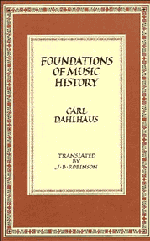Book contents
- Frontmatter
- Contents
- Translator's preface
- Foreword
- 1 Is history on the decline?
- 2 The significance of art: historical or aesthetic?
- 3 What is a fact of music history?
- 4 Does music history have a ‘subject’?
- 5 Historicism and tradition
- 6 Hermeneutics in history
- 7 The value-judgment: object or premise of history?
- 8 The ‘relative autonomy’ of music history
- 9 Thoughts on structural history
- 10 Problems in reception history
- Bibliography
- Index
10 - Problems in reception history
Published online by Cambridge University Press: 01 June 2011
- Frontmatter
- Contents
- Translator's preface
- Foreword
- 1 Is history on the decline?
- 2 The significance of art: historical or aesthetic?
- 3 What is a fact of music history?
- 4 Does music history have a ‘subject’?
- 5 Historicism and tradition
- 6 Hermeneutics in history
- 7 The value-judgment: object or premise of history?
- 8 The ‘relative autonomy’ of music history
- 9 Thoughts on structural history
- 10 Problems in reception history
- Bibliography
- Index
Summary
There has been a noticeable, at times even polemical and propagandistic, upsurge of interest in what is called the history of ‘impact’ or ‘reception’ (the former term emphasises the object that sets the process in motion, the latter the public towards which that process is directed). This turn of events can be seen as an outgrowth and consequence of the crisis which, beginning in art itself and later moving to art theory, has befallen the concept of the autonomous and self-contained work. We might even yield to the current argot of the subject and say that the authority of the art work has atrophied in an age imprinted with the thought processes of ideology critique. As long as a musical creation was still considered an ‘ideal object’ with an immutable and unshifting ‘real’ meaning, whether or not this meaning had been fully or even partly comprehended, reception history seemed at best a secondary venture, if not altogether superfluous. The point was to find the interpretation that could lay sole claim to absolute verity, not to explain why most interpretations were inadequate. There was little sense in reflecting on the historical conditions behind the varying interpretations given to a work of art when the task at hand was to unveil the material content or truths that dwelt, or were thought to dwell, within it. Conflicting views were studied not for their causes but for their cogency.
- Type
- Chapter
- Information
- Foundations of Music History , pp. 150 - 165Publisher: Cambridge University PressPrint publication year: 1983
- 3
- Cited by



